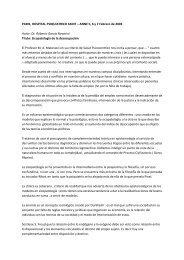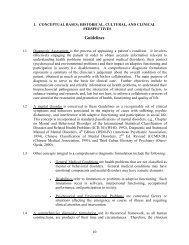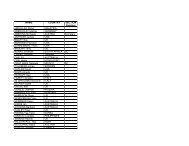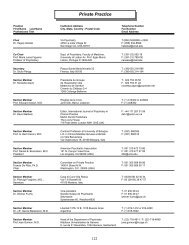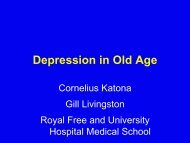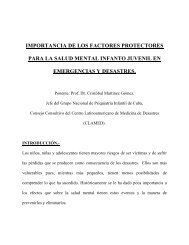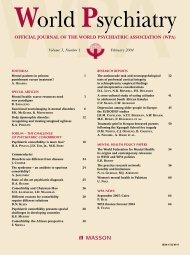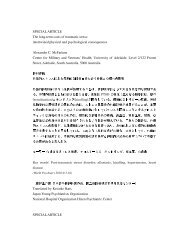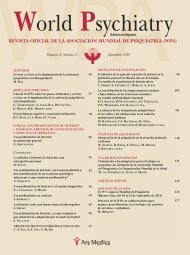ABSTRACTS - World Psychiatric Association
ABSTRACTS - World Psychiatric Association
ABSTRACTS - World Psychiatric Association
Create successful ePaper yourself
Turn your PDF publications into a flip-book with our unique Google optimized e-Paper software.
specifically, these studies have either investigated single fiber tracts<br />
(i.e., using region of interest analysis) or they have relied upon error<br />
prone DTI normalization to the template space (i.e., voxel based morphometry,<br />
VBM analyses). Here the focus is on whole brain analytic<br />
approaches, where existing VBM DTI data analyses are presented as<br />
well as recent methodological advances in studying WM alterations<br />
in schizophrenia. Two new methods of whole brain data analysis,<br />
atlas based segmentation and group based spectral clustering, are<br />
introduced, and results using these new methods are reported from a<br />
dataset that includes 25 chronic schizophrenia subjects and 25<br />
healthy controls. Findings are presented from the two methods and<br />
the implications from these studies are discussed, as well as the<br />
advantages and disadvantages of using these methods vs. more conventional<br />
VBM methods.<br />
RS2.3.<br />
DIFFUSION TENSOR TRACTOGRAPHY<br />
IN FIRST-EPISODE SCHIZOPHRENIA<br />
G. Price, M. Cercignani, G. Parker, D. Altmann, T. Barnes,<br />
G. Barker, E. Joyce, M. Ron<br />
Institute of Neurology, University College, London, UK;<br />
Imperial College Faculty of Medicine, London, UK;<br />
Institute of Psychiatry, King’s College, London, UK; Santa Lucia<br />
Foundation, Rome, Italy; Imaging Science and Biomedical<br />
Engineering, University of Manchester, UK; Medical Statistics<br />
Unit, London School of Hygiene and Tropical Medicine,<br />
London, UK<br />
Disconnectivity abnormalities in the cortex and connecting white<br />
matter pathways may explain the symptoms and cognitive abnormalities<br />
of schizophrenia. Recently, diffusion imaging tractography has<br />
made it possible to study white matter pathways in detail in vivo and<br />
in this paper a corpus callosum study (18 patients and 21 controls)<br />
and an uncinate fasciculus study (19 patients and 23 controls) are presented<br />
for a sample of patients with first-episode schizophrenia using<br />
a probabilistic tractography algorithm. In the study of the corpus callosum,<br />
seed points were placed in the splenium and genu to track fibre<br />
tracts crossing these regions. A multi-threshold approach and multiple<br />
linear regressions were used to explore group differences. Fractional<br />
anisotropy (FA) was reduced in tracts crossing the genu, and to<br />
a lesser degree the splenium, in patients compared with controls. In<br />
the study of the uncinate fasciculus, two seed points were used to isolate<br />
the tract in each hemisphere. FA and probability of connection<br />
were obtained for every voxel in the tract and the group means and<br />
distributions of these variables were compared. The FA distribution,<br />
as measured by the squared coefficient of variance, was reduced in the<br />
left uncinate fasciculus in the patient group, indicating that the number<br />
of voxels with high FA values was reduced, suggesting abnormalities<br />
in the core of the tract. These studies suggest that there are subtle<br />
abnormalities in structural connectivity in patients that may involve<br />
aberrant connectivity in the core of the white matter tract.<br />
RS2.4.<br />
WHITE MATTER VOLUME, ANISOTROPY,<br />
AND TRACT TARGETING QUALITY IN<br />
SCHIZOPHRENIA: FIXED OR PROGRESSIVE<br />
M.S. Buchsbaum, S. Mitelman, E.L. Canfield, J. Schneiderman,<br />
K.-W. Chu, J.J. Entis, E.A. Hazlett, M. Haznedar, I. Nenadic,<br />
J. Zhang, J. Friedman<br />
Mount Sinai School of Medicine Department of Psychiatry,<br />
New York, NY, USA<br />
Several studies have suggested progressive focal gray matter loss in<br />
schizophrenia, but longitudinal white matter changes in anisotropy<br />
have not yet been systematically assessed regionally. Two studies were<br />
conducted: a) diffusion-tensor and structural magnetic resonance<br />
imaging in a cohort of 49 schizophrenia patients and 16 controls<br />
scanned twice 4 years apart; patients were subdivided into good-outcome<br />
(n=23) and poor-outcome; b) 3T-MP-RAGE anatomical and<br />
diffusion tensor images on 111 patients with schizophrenia and 222<br />
normals. Placement of images in standard AC-PC position, coregistration<br />
of DT images to the anatomical images, computation of<br />
anisotropy and tract-angles was done with FSL. White matter and<br />
gray matter volumes and fractional anisotropy were parcellated into<br />
Brodmann areas and entered into multiway ANCOVA. In the followup<br />
sample at baseline, anisotropy was lower in patients and they<br />
showed larger white matter volume. Over four years, anisotropy<br />
declined more in controls bringing normal and schizophrenia levels<br />
closer; controls showed small white matter increases, again bringing<br />
them closer to patient values. For anisotropy and white matter,<br />
patients with good outcome showed a pattern not dissimilar to controls,<br />
but gray matter volume loss continued in poor-outcome<br />
patients. Tract angles changed little over time. In the cross-sectional<br />
sample, lower anisotropy was observed widely in schizophrenia, but<br />
most prominently in the frontal and temporal lobes. Both volumetric<br />
and anisotropy changes in white matter over time appear to be in the<br />
direction of effacement of between-groups differences among schizophrenia<br />
patients and controls. Tract angles and total length were<br />
reduced in schizophrenia, but less altered over time.<br />
RS3.<br />
CLINICAL FEATURES AND PHARMACOLOGICAL<br />
TREATMENT OF BIPOLAR MIXED DEPRESSIONS<br />
RS3.1.<br />
THE “TROUBLED WATER” OF TREATMENT<br />
OF BIPOLAR MIXED DEPRESSIONS<br />
F. Benazzi<br />
Hecker Psychiatry Research Center, Forlì, Italy; University<br />
of California at San Diego, CA, USA<br />
Bipolar depressions are difficult to treat. Mood stabilising agents are<br />
more effective for mania than depression. Only olanzapine/fluoxetine<br />
combination and quetiapine are FDA-approved for bipolar (type I)<br />
depression, but none of the antidepressants used in unipolar depression.<br />
While some controlled studies on bipolar depression have shown<br />
that antidepressants are not better than placebo or lithium, some large<br />
naturalistic studies (closer to “real-world” patients) have shown effectiveness<br />
of antidepressants. As bipolar depression is often mixed (i.e.,<br />
with concurrent manic/hypomanic symptoms), and most antidepressants<br />
studies have not been stratified according to mixed status, the<br />
results of these studies are questionable, as bipolar mixed depression<br />
may be worsened by antidepressants (statistically wiping out positive<br />
32 <strong>World</strong> Psychiatry 8:S1 - February 2009




